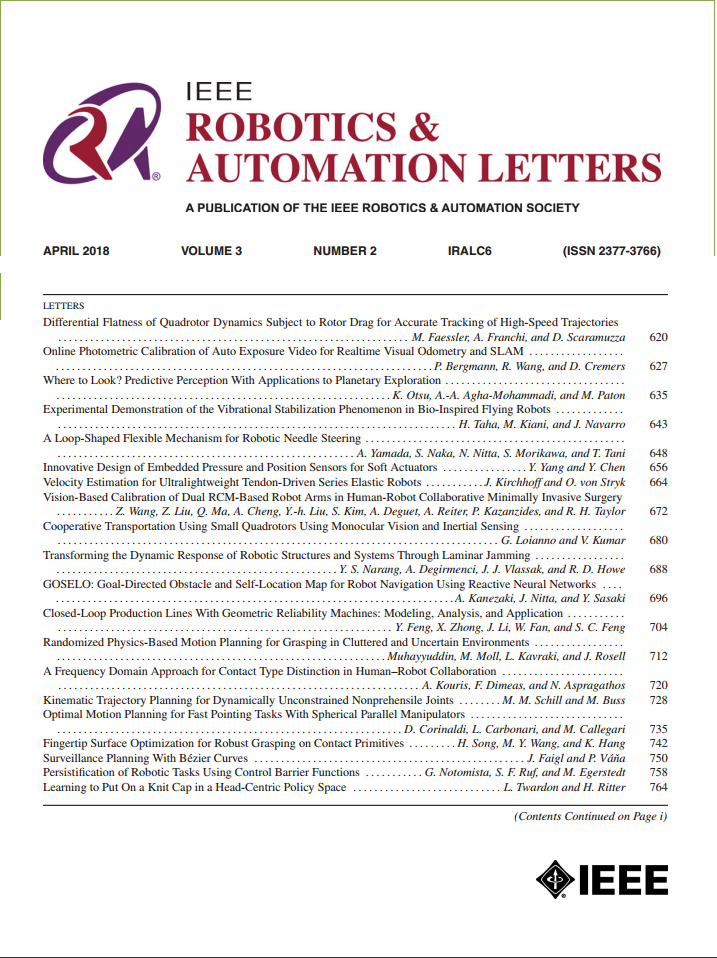A Highly Maneuverable Flying Squirrel Drone With Agility-Improving Foldable Wings
IF 4.6
2区 计算机科学
Q2 ROBOTICS
引用次数: 0
Abstract
Drones, like most airborne aerial vehicles, face inherent disadvantages in achieving agile flight due to their limited thrust capabilities. These physical constraints cannot be fully addressed through advancements in control algorithms alone. Drawing inspiration from the winged flying squirrel, this letter proposes a highly maneuverable drone with agility-enhancing foldable wings. The additional air resistance generated by appropriately deploying these wings significantly improves the tracking performance of the proposed “flying squirrel” drone. By leveraging collaborative control between the conventional propeller system and the foldable wings—coordinated through the Thrust-Wing Coordination Control (TWCC) framework—the controllable acceleration set is expanded, allowing for the production of abrupt vertical forces unachievable with traditional wingless drones. The complex aerodynamics of the foldable wings are captured using a physics-assisted recurrent neural network (paRNN), which calibrates the angle of attack (AOA) to align with the real-world aerodynamic behavior of the wings. The model is trained on real-world flight data and incorporates flat-plate aerodynamic principles. Experimental results demonstrate that the proposed flying squirrel drone achieves a 13.1具有可折叠机翼的高机动性鼯鼠无人机
无人机,像大多数机载飞行器一样,由于其有限的推力能力,在实现敏捷飞行方面面临着固有的缺点。这些物理限制不能仅仅通过控制算法的进步来完全解决。从有翅膀的鼯鼠中获得灵感,这封信提出了一种高机动性的无人机,具有增强敏捷性的可折叠机翼。适当部署这些机翼所产生的额外空气阻力显著提高了拟议的“鼯鼠”无人机的跟踪性能。通过利用传统螺旋桨系统和可折叠机翼之间的协同控制-通过推力-机翼协调控制(TWCC)框架进行协调-扩展了可控加速度集,允许产生传统无翼无人机无法实现的突然垂直力。利用物理辅助循环神经网络(paRNN)捕获可折叠机翼的复杂空气动力学,该网络可校准迎角(AOA),以使其与机翼的实际空气动力学行为保持一致。该模型是根据真实飞行数据训练的,并结合了平板气动原理。实验结果表明,与传统的无翼无人机相比,采用均方根误差(RMSE)测量的鼯鼠无人机的跟踪性能提高了13.1%。
本文章由计算机程序翻译,如有差异,请以英文原文为准。
求助全文
约1分钟内获得全文
求助全文
来源期刊

IEEE Robotics and Automation Letters
Computer Science-Computer Science Applications
CiteScore
9.60
自引率
15.40%
发文量
1428
期刊介绍:
The scope of this journal is to publish peer-reviewed articles that provide a timely and concise account of innovative research ideas and application results, reporting significant theoretical findings and application case studies in areas of robotics and automation.
 求助内容:
求助内容: 应助结果提醒方式:
应助结果提醒方式:


